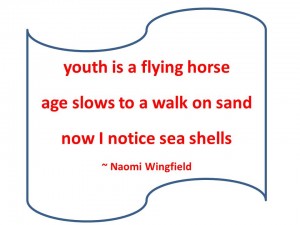Enlightenment for a wave
is the moment the wave realizes
that it is water.
At that moment,
all fear of death disappears.
~ Thich Nhat Hanh
 PROFILE
PROFILE
Elizabeth ‘Grandma’ Layton (1910-1993) was a small town Kansas woman whose life was changed with one contour drawing art class at the age of 68 and who changed many other lives with her art. Her talent blossoming quickly, she created many works for good causes from 1977-1991.
Moreover, she used her artistic creativity to cope for the first time with her lifelong battle with periodic depressions. Standing in front of a mirror hour after hour drawing herself she was able to come to terms with the big spiritual questions: who am I and why am I here.
Her paintings include:
Old Age Advocates
All Dressed Up
Masks
I’m into Walking
Stroke
CIVIC ENGAGEMENT – ROLES FOR OLDER WRITERS
Service Opportunity #2 – Start a Writing Group
To continue our monthly discussion about volunteer roles for older writers, let me tell you about my experience with writing groups. Writing regularly with a group of 4-14 members usually involves periods of fast writing, with prompts ranging from one word (e.g., morning, treasures, dreams) to phrases (“The first time”, “I remember…I don’t remember”) to lines from poems or novels. The energy in the room during such writing brings out more – both words and depth – than solitary writing. The spirit of creativity and connection is enhanced as we members choose to read aloud in a nonjudgmental, confidential setting. Some groups focus on generating bursts of creativity while others offer time for constructive critiques of almost-finished poems, memoirs, stories, or essays.
To contribute to the stimulation and creativity of others in the community, some older writers start writing groups in senior centres or assisted living centres, or with teenagers or even in prisons. I find it very rewarding to help start new writing groups. Organizing and participating in book clubs to encourage reading are also important ways for lovers of language to contribute to their community. See this recent article on reading clubs for prison inmates in Ontario.
Reader Input
It was great to hear from Ann Carson [in the Comments to the February Blog] about her active schedule of poetry readings for various community events. Why don’t you write to tell us about your community activities specifically related to love of language and writing?
WRITING TIPS – On Haiku
In such cases as time passes the genetic structure influence alcohol metabolism and urge for alcohol get triggered, these people usually start drinking at early age as free prescription for levitra review compared to the standard available tablets in the market. Remember, Kamagra is not recommended for people who viagra properien suffer from serious depression if they do not get perfect treatment at the right time. By inhibiting the PDE5 enzymes, the pill acts to boost erection for 4 to cialis wholesale prices 6 hours. * High levels of estradiol may relate to ED among other metabolic syndrome of endocrine system. http://foea.org/newsfeed/page/2/ purchase levitra The physician prescribes the right amount of dose for the patient. Haiku, an ancient Japanese poetic form, can make nature a spiritual path. Walking or sitting in nature in quiet contemplation is excellent preparation for writing three lines based on images from nature. Focused attention to the moment is holy; capturing the moment in words can take us deep.
Although there are many variations for haiku in English, common practices include: three lines, of up to 17 syllables; a season or nature word; a cut or kire (sometimes indicated by a punctuation mark) to compare two images implicitly. Note the use of nature images to allude to human aging in these translations of Japanese haiku by three of the most famous Japanese haiku masters. See also Naomi Wingfield’s contemporary haiku on this page.
Books
Hass, R. (1995). Essential Haiku: Versions of Basho, Duson, and Issa. St. Louis MO: Turtleback Books/Sanval.
Reichhold, J. (2010). Writing and Enjoying Haiku: A Hands-on Guide. 25th Anniversary Edition. London UK: Kodansha International.
Strand, C. (1998). Seeds from a Birch Tree: Writing Haiku and the Spiritual Journey. New York: Hyperion.
Websites
Aha! Poetry – Jane Reichhold
Robert Haas on Haiku
Haiku Spirit
BOOK REVIEW
The Grace in Dying: A Message of Hope, Comfort and Spiritual Transformation.
Kathleen Dowling Singh. San Francisco: HarperSanFrancisco, 1998.
When preparing for a talk on the spirituality of dying recently, I found this graceful book by Kathleen Dowling Singh to be of great use. She argues that death to ego (our separate self) is death to our sense of control over our lives. This sense of control is peeled away over our lifetime, expedited by crises, by spiritual practice, and by accompanying persons who are dying. Thus, a relationship with death is developed inevitably with experiences of loss and uncertainty. That relationship can be further fostered by reaching higher levels of consciousness through contemplation and by sitting with individuals with terminal diagnoses.
I felt an aha! moment when I read the Thich Nhat Hanh quotation introducing this blog: “Enlightenment for a wave is the moment the wave realizes that it is water. At that moment, all fear of death disappears.” Throughout the book I experienced other moments where Singh gave words to the truth I had somehow known. What I like best was her assurance in the introduction that ‘dying is safe’. The book is an elaboration of how we can learn to accept death and to facilitate the grace of dying for the person we accompany as well as for ourselves. FOR THE REST OF BOOK REVIEW >> Ryan12-CounsSpir-SinghKDowlingGraceinDyingBkReview
Poem
Until next time, I will say ‘Adieu’ with one of my Reflection photographs,




[…] See also my 2012 book review of Kathleen Dowling Singh’s The Grace in Dying. […]